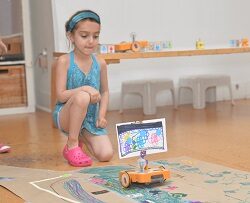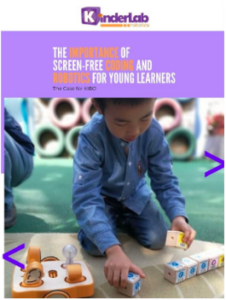Making Lesson Plans More Engaging with Screen-free Robotics for Elementary Students
Teachers struggle to teach in a way that captures kids’ attention. Young children have a naturally short attention span, but all children, regardless of age, seem to have a shorter attention span than they did twenty years ago before technology changed the way their brains process information. As such, classroom learning has also had to evolve to help children grasp concepts and remain engaged. What if there are ways to integrate technology, including robotics for elementary students, with instruction in a screen-free way to engage young learners?
Over the last two decades, the increased use of computers and tablets, particularly in the classroom, has been met with some debate. Unintended negative effects on children’s attention spans as well as their cognitive function has become evident with screen-based learning. Research shows that screen time effectively captures children’s attention; however, it can have negative effects on young children’s physical, cognitive, and emotional development. Examples of negative physical effects are related to the sedentary nature of looking at a computer or tablet screen.

In young children, physical movement is important to both muscle and brain development. In addition, excessive screen time can result in a decrease in creative thinking and vocabulary development because the child has fewer opportunities for interacting with their peers and educators. Excessive screen time can also cause emotional problems including feelings of isolation and depression.
Balancing Technology and Classroom Curriculum to Foster Engagement
Although computers and tablets have many educational benefits, their use must be balanced with other teaching methods that incorporate hands-on activities, verbal discussions, and problem-solving opportunities. So how can a teacher make a lesson engaging without relying on computers to capture children’s attention?
The best lessons are interactive and allow the students to be both creative and collaborative. One resource that can develop higher-order thinking skills, bridge the gap between technology and real-world learning, and greatly increase student engagement is to teach coding to students using actual robotics for elementary age students that are developmentally appropriate, such as KIBO. Unlike many coding resources, this screen-free coding robot for elementary schools was created specifically for young children from preK-5th grade. KIBO robotics for elementary students don’t require monitors or tablets as children interact with the robot to create stories through coding that are as limitless as a child’s education. KIBO comes to life based on a coding sequence a young student creates.
Critical Thinking and Play Based Learning through Robotics for Elementary Students
Why are play-based, interactive, and open-ended tasks, such as KIBO robotics for elementary, important to student learning?
- When students choose from a variety of choices, they are making decisions. Decision-making is a higher-order thinking skill that helps develop the prefrontal cortex of a young child’s brain.
- The coding process requires the child to develop a sequence of programmable wooden building blocks for their robot to scan. Sequencing is a critical pre-reading skill.
- Understanding what happens first, next, and after an event helps children develop skills in prediction and understanding cause and effect.
Higher Order Thinking Skills are a Natural Consequence of Coding
While some coding programs use graphic images and are screen based, one study compared a robotic for elementary school coding program presented in two formats – online, and hands-on. Although both formats taught students how to code, the students reported they preferred and were more engaged with the tangible, hands-on robotics.
The science behind learning indicates that when multiple senses are activated, multiple parts of the brain are engaged. Listening activates one part of the brain. Observation activates a different part. Children who watch, listen, discuss, touch, and talk about a concept are more likely to understand it and learn from the activity. The more senses a young child uses to learn, the more likely it is that the concept will be transferred into long term memory.
In an age of heightened distraction due to the bombardment of information and media available online, providing hands-on robotic coding activities such as KIBO can help teachers keep students engaged while teaching high quality STEM concepts effectively.
Meet KIBO – Screen-free Educational STEAM Robotics for Elementary
There are many robotics for elementary students available to teach young people about coding fundamentals. So why KIBO? KIBO is a screen-free way to engage and learn while giving them a fertile environment for other aspects of their growth. Using programmable wooden building blocks that can be placed and manipulated to create sequences that will direct a robot’s movements, it addresses a growing understanding of technology’s impact on childhood development and allowing us to rethink the amount of time children interface with computers.
More about KIBO
KIBO, the learning robot designed specifically for early learners from Prek through 5th grade, offers an inviting, engaging platform for young children to start their journey into creating with code in a fun and creative way. KIBO’s block-based coding language gives children control over the robot’s movements, sounds, and sensors, allowing them to express their imaginations with code. The KIBO curriculum for educators also teaches children to tell stories, create characters, and explore the world around them through code. KIBO is the number one choice in screen-free coding for kids – trusted by more parents and schools to introduce today’s youth to the wonders of technology and robotics.
Learn more about why KIBO is so different – and so important – for your young learners, as it is designed to be extended with craft and other building materials, providing a platform for imaginative play, where children develop their computational thinking, and the engineering design process.
KIBO pulls together constructive play, problem solving, critical thinking, hands-on learning, and more!
Learn the 6 Key Benefits of Using Robotics with Your Youngest Students!
![]() Introduce coding and robotics into your early childhood classrooms – in a fun and playful way!
Introduce coding and robotics into your early childhood classrooms – in a fun and playful way!



















